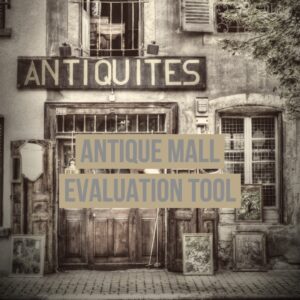So many people today are looking for a way to make some additional money or to get out of the corporate rat-race. I’m guessing that is why I get asked this question so often, “How does the antique booth business work?”
First of all, let me tell you that anyone can do this. It isn’t rocket-science, but it is hard work. Small business retailers wear a lot of hats- we are the buyers, sellers, designers, marketers, etc. I also want to be very clear when I say I LOVE THIS and IT IS SO MUCH FUN. There is nothing I would rather do as a career. That is why I want to share my experiences and ideas with you.
Find an antique mall
The first step in starting an antique booth business is finding an antique mall. Antique malls are found in nearly every city and in many small towns. The best way to find antique malls in your area is to search for them using Google Maps on your phone or computer.
There are a number of key benefits to having your antique business located in an antique mall. Some of these benefits include:
- Employees: the mall already has them- so there is no need to recruit or hire
- Commercial Location: You don’t have to pay a long-term commercial lease on a building or land. You also won’t have an electric or utility bill. You won’t pay for building or parking lot maintenance. All your building costs are included in your rent.
- Technology: You won’t have to invest in a point-of-sale system, WIFI, or phone service.
- Pre-existing Traffic: Your mall comes with a built-in-reputation, and a loyal customer following.
Choosing the right antique mall is essential for the success of your business, so I put together the free Antique Mall Evaluation Tool below. I would definitely recommend you use it to help you compare the antique malls you consider.

Don't make the mistake of picking the wrong antique mall!
Get the Free Antique Mall Evaluation Tool to help you choose the right mall for your antique booth business.
Speak to mall management about their general policies and procedures
They will be able to tell you all the ins and outs of being a dealer in their mall. Because malls vary in their practices, I will share with you some of the most common procedures.
- Dealers rent booths (sometimes called ‘stalls’ or ‘spaces’), typically by the square foot. Booths may or may not have physical partitions, shelving, electrical outlets, etc.
- In addition to rent, malls often charge fees- including commissions (a percentage of sales), credit card transactions, and advertising
- Malls may require dealers to have and maintain a small business license, and be registered with their state
- Some malls expect dealers to work at the mall in a customer service capacity for a certain number of hours on a regular basis (e.g. weekly or monthly)
- There may be restrictions on running sales and/or discounts
- Certain malls require dealers to specialize in a particular product category such as pottery, glassware, furniture, etc.
- One mall may require that you only sell true-antiques while others may allow all kinds of vintage, DIY, or home décor items
Sign a contract with the antique mall
Most malls expect dealers to sign a legal contract, similar to any other rental agreement. Contracts vary, with some being month-to-month and others requiring commitments of 3-6 months. Some malls also require renter’s insurance to cover your booth.
Move in and design your booth space
This is where it starts to get exciting! You get to decorate your walls, ceilings, floors; set up any permanent shelving or fixtures, and even hang a sign or two with your business name. Perhaps you would have as much fun as I did!
Merchandise your goods
Now, you get to set up everything that you are selling. Whether it be furniture, art, collectibles, clothing, YOU get to decide where to place it all. Of course, I have acquired some expertise in this area after almost two decades in the retail industry, as well as many years in the antiques business, so make sure you subscribe to our email list at the bottom of this page to get additional tips.
How antique booths work for customers
I want to take a moment here to give a brief explanation for those of you who may not be familiar with how it works to shop in an antique mall. While malls do vary, they generally work like this:
- The checkout counter is located near the front entrance of the mall
- Several mall employees walk around the mall to provide assistance to customers
- Customers are free to roam around the mall- visiting any booths they choose- and collecting items they wish to purchase along the way. Should there be a mall employee nearby, customers can turn over their pending purchases to be stored for them at the front checkout. Mall employees will also have the keys to open any locked cases for customers.
- Antique booth prices are typically non-negotiable (no haggling), with some exceptions. For example, in my mall, if an item is priced at more than $100, the customer can request that the mall employee call the dealer and make them an offer.
- When the customer has finished shopping, they go directly to the checkout counter to retrieve anything being held and to make their purchases.
Give every item a price tag
Your mall may provide you with the opportunity to purchase their blank price tags, or you can either make or purchase your own. There is certain information that every antique booth price tag must include:
- Booth number
- Price
- Item description
Having your booth number on your price tag ensures that you will get credit for the sale. Having an accurate item description on your tags is a preventative measure to ensure that price tags do not get switched. The mall’s cashier will allocate each customer transaction to the appropriate dealer based upon the information on the price tag.
After trying a number of different tag options, I now use these tags for much of my pricing. The price per tag is great, they are already pre-strung, and they are durable. 1,000 tags might sound like a lot but you will go through them in no time!
If you want to learn more about making your own price tags, check out my post 10 Proven Price Tag Strategies to Maximize Antique Booth Profits.
How antique malls track transactions
If you are wondering how the mall keeps track of each transaction to make sure that the correct dealer is given the right credit for the exact item, here’s how that works:
Go home and let the mall handle the rest
This is the best part about being a dealer in an antique mall. You do not have to “man your booth”. You are now free to move about the country (as they say in the airline industry). Go create. Shop. Build. Travel. You can rest assured that while you are away from the mall, customers will be shopping in your booth, mall employees will be providing them with customer service, and you will be making money.


